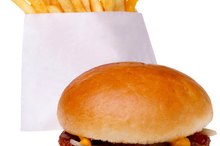What Are the 19 Steps in the Digestion of Food?
The National Digestive Diseases Information Clearinghouse defines the digestive tract as “a series of hollow organs joined in a long, twisting tube from the mouth to the anus.” Almost all foods that enter the body provide some sort of nourishment -- whether protein, carbohydrates, fats, sugars or vitamins. But before the body can use these nutrients, a complex digestive process allows the particles to be broken down into minuscule molecules small enough for absorption into the bloodstream.
Mouth and Throat
The first step of the digestive process occurs before food even enters your mouth. Once you smell or see food that you plan to eat, you begin to salivate, and the digestive process begins. Once food enters your mouth, your teeth and tongue begin breaking it apart; this second step is a form of mechanical digestion. As you chew, the saliva begins to mix with the food. Saliva not only helps make the food softer and easier to swallow, but it also helps break down the chemicals in the food; this third step is a form of chemical digestion.
Once a ball of mashed-up food and saliva forms, your tongue takes care of step four by pushing the ball of food to the back of the throat and into the opening of the esophagus. The esophagus is a flexible tube that extends from the mouth to the stomach. Step five involves the ball of food passing through the esophagus, where circular bands of muscles slowly contract and squeeze the food, providing further mechanical digestion.
- The first step of the digestive process occurs before food even enters your mouth.
- Once a ball of mashed-up food and saliva forms, your tongue takes care of step four by pushing the ball of food to the back of the throat and into the opening of the esophagus.
Stomach
Steps of Food Digestion
Learn More
Once the food reaches the end of the esophagus, it passes into the stomach -- step six. Steps seven and eight occur in the stomach, where mechanical and chemical digestion continue to occur. The stomach secretes highly acidic gastric juices that chemically break down the food and help kill any bacteria or dangerous microorganisms that entered the stomach with the food. The strong muscles that surround the stomach also provide mechanical digestion as they churn and mix the stomach contents together. Once this process has finished -- usually about three to four hours -- the food in your stomach no longer resembles the food on your plate. It has been sufficiently digested and can pass into the intestines. By opening and closing a small valve at the bottom of the stomach, your body slowly allows small amounts of the liquid stomach contents into the small intestine -- this is step nine of the digestive process.
- Once the food reaches the end of the esophagus, it passes into the stomach -- step six.
- By opening and closing a small valve at the bottom of the stomach, your body slowly allows small amounts of the liquid stomach contents into the small intestine -- this is step nine of the digestive process.
Accessory Organs
Before the small intestine can process the stomach contents, three accessory organs play a role in digestion. The liver and gallbladder contribute to step 10, while the pancreas is responsible for step 11. As stomach contents pass by the liver and gallbladder, a strong chemical called bile mixes with the contents. Although bile is produced in the liver, it is stored in and released by the gallbladder. Bile helps digest fat particles in the food, breaking them down into small droplets. The pancreas then releases a digestive chemical to help with the digestion of carbohydrates and proteins.
- Before the small intestine can process the stomach contents, three accessory organs play a role in digestion.
- The pancreas then releases a digestive chemical to help with the digestion of carbohydrates and proteins.
Intestines
How Are Nutrients Absorbed in the Body by the Stomach?
Learn More
As the stomach contents and digestive chemicals move through the small intestine, the most important step in digestion takes place. Step 12 involves the complete digestion of food in the small intestine. During this step, the particles finally become small enough that the nutrients can be absorbed into the bloodstream. Thousands of small blood vessels line the surfaces of the small intestine. These blood vessels absorb the digested nutrients -- step 13 -- and send them to various areas of the body through blood circulation -- step 14. This nutrient-rich blood travels directly to the liver, where step 15 and 16 involve the processing and delivery of these nutrients to the rest of the body.
The 17th step in the digestive process occurs when all the unused food particles from the small intestine move into the large intestine. Step 18 also occurs in the large intestine, where all the water is removed from the remaining particles and absorbed back into the bloodstream. After about 12 hours in the large intestines, the remaining contents -- known as feces -- are sent to the rectum for excretion from the body. This is the final 19th step in the digestion of food.
- As the stomach contents and digestive chemicals move through the small intestine, the most important step in digestion takes place.
- After about 12 hours in the large intestines, the remaining contents -- known as feces -- are sent to the rectum for excretion from the body.
Related Articles
References
- KidsHealth; Digestive System; May 2010
- KidsHealth; Your Digestive System; June 2010
- Bornhorst GM, Singh RP. Bolus formation and disintegration during digestion of food carbohydrates. Compr Rev Food Sci Food Saf. 2012;14(4):431–445. doi:10.1111/j.1541-4337.2011.00172.x
- National Institutes of Health, National Institute on Deafness and Other Communication Disorders. Dysphagia. Updated March 6, 2017
- National Institute of Diabetes and Digestive and Kidney Diseases. Your digestive system & how it works. December, 2017
- Aggarwal L, Sattavan S, Lal R, Sharma D, Borgharia S, Shrivastava N, Alagappan R, Singh R. Short bowel syndrome: An uncommon clinical entity and a therapeutic challenge-our experience and review of literature. Indian J Surg. 2017;79(4):349-353. doi:10.1007/s12262-017-1651-x
- Dabirian A, Yaghmaei F, Rassouli M, Tafreshi MZ. Quality of life in ostomy patients: a qualitative study. Patient Prefer Adherence. 2010;5:1-5. doi:10.2147/PPA.S14508
- Fargo MV, Grogan SP, Saguil A. Evaluation of jaundice in adults. Am Fam Physician. 2017;95(3):164-168.
Writer Bio
Krista Sheehan is a registered nurse and professional writer. She works in a neonatal intensive care unit (NICU) and her previous nursing experience includes geriatrics, pulmonary disorders and home health care. Her professional writing works focus mainly on the subjects of physical health, fitness, nutrition and positive lifestyle changes.









